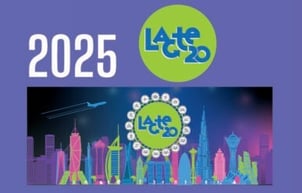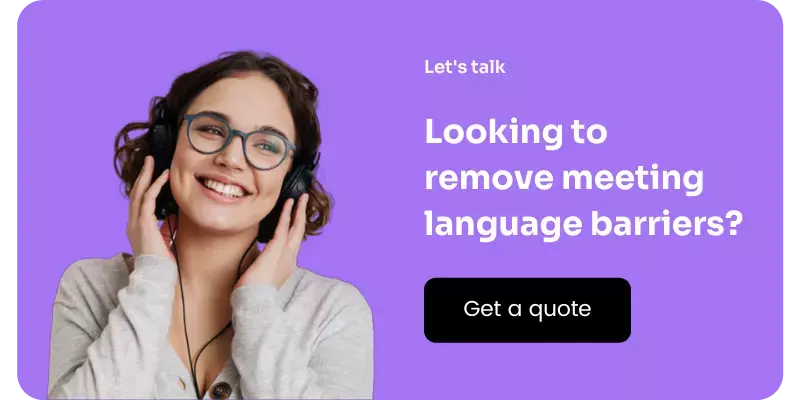With the rise of online video conferencing technology, it has become easier for brands to create events that can reach large, multi-national audiences. But reaching new listeners isn’t the same as getting through to them. For that, you need to be able to speak their language.
Language is a major barrier when organising an inclusive virtual event. There are many types of translation services available, including: real-time AI translation, interpreting technology, and written translation such as captions and subtitles. However, it can be difficult to choose a service that best fits the needs of your event. This article explores why adding web conferencing with language translation to events is key to driving meaningful brand engagement.
What is live language translation for events and video conferences?
At events where communication is key, securing the support of interpreters or translators is necessary to communicate effectively. For many, the difference between translation and interpretation is unclear; that’s why we’ve written a blog post differentiating translation, captions, interpretation and subtitlesTo summarise, interpretation deals with spoken language in real time, while translation focuses on written content. Notably, translation happens over a period of time with extensive access to external resources, while interpretation occurs on the spot during a live scenario.
When hosting a virtual event, real-time interpreting technology can ensure no one is left out of the conversation. One of the ways to do this is via Remote Simultaneous Interpretation (RSI), which allows for interpreters to work remotely, more languages to be covered and, as a result, more inclusive events. RSI is useful for hybrid, virtual and on-site events and usually involves cloud-based technology, such as Interprefy, to provide a virtual interpreter interface and a video conferencing user interface, or a mobile app for attendance with a language selector for the audience. The interpreter is then able to convey the message into the language you have chosen, in real time, while the talk is in progress.
With the advancements in AI technology, automated real-time translations are now possible. This allows for simultaneous automatic translation with live captioning. By making use of automatic, live closed captioning you can ensure better engagement, comprehension and accessibility to your event. There are two approaches to multilingual live captions: Automated Speech Recognition (ASR) and Machine-Translated Captions (MTC). ASR provides a written transcription of the spoken words in real time, while MTC goes a step further and provides a written translation of the speech, in the language of your choice in real time. Live language interpretation is accessible for all events, regardless if they are in-person, hybrid or solely online.
Why you should include language translation in your marketing events
Including video conferencing language translations for your events improves brand perception by promoting inclusivity. It also creates a more impactful experience for participants whose languages and communication needs you cater for.
5 benefits of live language translation
- Reaching larger and more diverse audiences
Online and hybrid events enable marketers to reach audiences on a significantly larger scale — but only if events cater for the languages spoken by new audiences. According to Netflix, by allowing subtitles for foreign language films and shows, they’ve had a 33% increase in international viewers. Live translations allow your event to cater for a global audience without a large cost.
- Increased accessibility
Live captions open your events to people who are deaf and hard of hearing.
According to an Ofcom study, up to 20% of audiences are hard of hearing. By increasing your accessibility you are opening up your brand to a wider market, and allowing your brand to receive better recognition which can help you outperform your competition.
- Improving user experience
Many event participants prefer reading captions, irrespective of whether they are hard of hearing — and captions help participants watch video content in a noisy environment. Written-text-like captions also make it easier to remember information and pay attention during events. Compared with consecutive interpretation, where participants have to wait for a human translator to interpret what is being said, real-time translations, whether human or AI powered, lead to more enjoyable viewing experiences. Audiences enjoy engaging with content in their own language. This limits the effort required to engage with events, as ideas and thoughts are often more easily understood when expressed in one's native language.
- Boosting SEO
Captions and translated captions attached to video files (e.g. SRT or VTT format) can be read by search engines like Google, which increases the chances of your content ranking higher in a search. Translations can also be repurposed to create transcripts, search-optimised blog posts, or captioned on-demand video content.
- Live language translation is a cost-effective solution
Because remote simultaneous interpretation allows the interpreter to work from anywhere, you no longer need to cover travel and accommodation expenses for them. This reduces their cost considerably, when compared to traditional in-person simultaneous interpretation. An even more cost-effective solution are machine translated captions, that can also be provided for multiple languages — so you’re less likely to not cater for a language due to budgetary constraints.
Want to learn how language interpretation can boost your webinar reach? Read this blog post.
Tips on finding the right language translation solution
There are many live translation solution providers available, but the quality of translation varies. To find the right live translation solution for your event, look for intuitive software that provides multiple solutions for multiple languages, especially languages spoken by your target audiences, and that integrates with common event platforms like ON24, Hopin, Webex Events, and Microsoft Teams.
Want to see if our interpreting technology can expand your audience? Get in touch with us.
Related articles:
- 6 ways to level up your online events
- Why you should consider adding live captions and subtitles to your next event


%20(15)%20(1).png?width=1040&height=800&name=Blog%20Header%20(1600%20%C3%97%20900%20px)%20(15)%20(1).png)


 More download links
More download links



